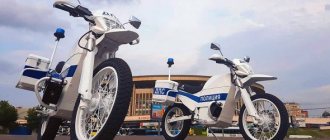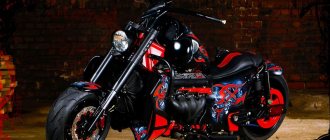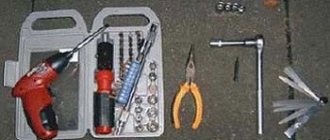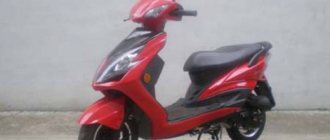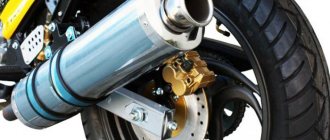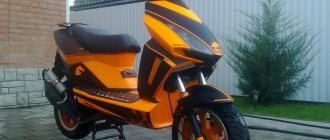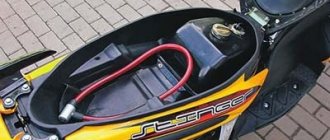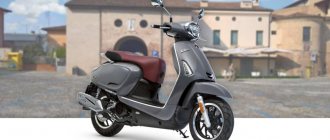Scooter AVM 50 Tornado Off Road Disk with engine capacity 49 cc/cm
Payment (installments without overpayment)
Delivery of goods (How can you receive the goods ordered from us)
1. Pickup from our warehouse:
Agree on the date and pickup point with your manager.
* In some cases, an advance payment for moving the goods may be required, which is automatically returned to the buyer upon receipt of the goods from the warehouse.
2. Delivery by our transport in Moscow and the Moscow region:
Products ordered in our online store are delivered throughout Moscow and the nearest Moscow region within 1-3 working days from the date of order.
Delivery is carried out during working hours from 9.00 to 18.00 (Weekends and evenings by agreement) on the day agreed with the Logistics Department. The exact delivery time is adjusted by the forwarding driver, depending on the traffic situation, and the buyer is notified by phone an hour in advance.
Delivery of goods in Moscow.
3. Shipping throughout Russia and abroad by transport and logistics companies:
You can see a detailed list of branches and representative offices in your region of the largest and most trusted transport companies in the section: Delivery in Russia.
Standard delivery terms:
When choosing this delivery method, the client must indicate his preferred transport company in the comments to the order.
From the moment the order is transferred to the Transport Company, the fact of which the store confirms by sending the client a scanned copy of the delivery note to the e-mail specified when placing the order, the store is not responsible for loss or damage to the goods by the Transport Company.
The transfer of goods to the Transport company is carried out within 3 working days after the actual receipt of payment into our account
We ship our goods to customers and partners in all regions of Russia. Dispatch is carried out by transport companies, our own vehicles, as well as through courier services and on the terms of self-pickup.
Upon receipt of funds in our bank account, we immediately dispatch the products. Delivery to a transport company in Moscow according to established tariffs; the cost of delivery itself is paid by the customer.
4. Sending goods by Russian Post (up to 20 kg) and EMS courier service (up to 31 kg):
Delivery by EMS Russian Post is carried out at the buyer's expense, the cost of delivery depends on the place of delivery and is agreed with the manager when confirming the order.
The order is sent by email after payment has been received into our account.
Important!
From the moment the order is transferred to the Russian Post office, the fact of which the store confirms by sending the client a scanned copy of the postal receipt to the e-mail specified when placing the order, the store is not responsible for loss or damage to the goods, as well as for delivery times.
List of cities to which we deliver equipment ordered from us by road:
Aprilevka, Balashikha, Bronnitsy, Vereya, prominent, Volokolamsk, Voskresensk, Vysokovsk, Golitsyno, Dedovsk, Dzerzhinsky, Dmitrov, Dolgoprudny, Domodedovo, Drezna, Dubna, Yegoryevsk, Zheleznodorozhny, Zhukovsky, Zaraysk, Zvenigorod, Ivanteevka, Istra, Kashira, Klimovsk, Klin, Kolomna, Korolev, Kotelniki, Krasnoarmeysk, Krasnogorsk, Krasnozavodsk, Krasnoznamensk, Kubinka, Kurovskoye, Likino-Dulyovo, Lobnya, Losino-Petrovsky, Lukhovitsy, Lytkarino, Lyubertsy, Mozhaisk, Moscow, Mytishchi, Naro-Fominsk, Noginsk, Odintsovo, necklace, lakes, Orekhovo-Zuevo, Pavlovsky Posad, Peresvet, Podolsk, Protvino, Pushkino, Pushchino, Ramenskoye, Reutov, Roshal, Ruza, Sergiev Posad, Serpukhov, Solnechnogorsk, Staraya Kupavna, Stupino, Taldom, Troitsk, Fryazino, Khimki, Khotkovo , Chernogolovka, Chekhov, Shatura, Shchelkovo, Shcherbinka, Elektrogorsk, Elektrostal, Elektrougli, Yubileiny, Yakhroma.
List of cities to which we deliver equipment ordered from us by transport companies:
St. Petersburg, Novosibirsk, Yekaterinburg, Nizhny Novgorod, Samara, Kazan, Omsk, Chelyabinsk, Rostov-on-Don, Ufa, Perm, Volgograd, Krasnoyarsk, Voronezh, Saratov, Tolyatti, Izhevsk, Yaroslavl, Ulyanovsk, Barnaul, Irkutsk, Khabarovsk , Vladivostok, Tyumen, Novokuznetsk, Orenburg, Kemerovo, Ryazan, Naberezhnye Chelny, Penza, Astrakhan, Lipetsk, Tomsk, Tula, Kirov, Cheboksary, Kaliningrad, Bryansk, Kursk, Magnitogorsk, Tver, Ivanovo, Nizhny Tagil, Belgorod, Arkhangelsk, Ulan -ude, Vladimir, Kaluga, Kurgan, Orel, Smolensk, Murmansk, Cherepovets, Chita, Volzhsky, Surgut, Saransk, Vologda, Tambov, Petrozavodsk, Komsomolsk-on-Amur, Kostroma, Sterlitamak, Nalchik, Yakutsk, Bratsk, Yoshkar-Ola , Dzerzhinsk, Nizhnevartovsk, Orsk, Angarsk, Syktyvkar, Nizhnekamsk, Stary Oskol, Biysk, Veliky Novgorod, Rybinsk, Engels, Blagoveshchensk, Norilsk, Balakovo, Petropavlovsk-Kamchatsky, Pskov, Severodvinsk, Armavir, Zlatoust, Kamensk-Uralsky, Syzran, Novocherkassk , Yuzhno-Sakhalinsk, Volgodonsk, Nakhodka, Berezniki, Abakan, Salavat, Rubtsovsk, Ussuriysk, Miass, Kovrov, Almetyevsk, Pyatigorsk, Kopeysk, Pervouralsk, Novomoskovsk, Odintsovo, Dimitrovgrad, Novocheboksarsk, Neftekamsk, Novy Urengoy, Murom, Kamyshin, Nefteyugansk, Cherkessk, Novoshakhtinsk, Yelets, Novokuybyshevsk, Derbent, Novembersk, Achinsk, Oktyabrsky, Kyzyl, Seversk, Arzamas, Obninsk, Leninsk-Kuznetsky, Zhukovsky, Mezhdurechensk, Kiselevsk, Ukhta, Elista, Artyom, Bataysk, Novotroitsk.
Fifty cc scooter engine. Four or two stroke?
Just a few years ago, the vast majority of scooters and mopeds with an engine capacity of up to 50cc were exclusively equipped with a two-stroke scooter engine. Now the situation has changed dramatically. Finding a new two-stroke scooter is getting harder and harder. Moreover, while Chinese manufacturers still produce such scooters, the Japanese and Europeans now produce exclusively four-stroke scooters. Although on a fairly large secondary market, finding a two-stroke scooter from the land of the rising sun is not yet a problem.
The situation is “aggravated” by many scooterists who, on various thematic forums, vehemently argue that a two-stroke scooter engine is a pure anachronism and it’s not worth looking at them at all. But is this really so? In the sub-50cc category, does a four-stroke scooter engine really have a significant advantage? Let's try to objectively understand and find out all the advantages and disadvantages of two-stroke and four-stroke engines. I warn you that all the arguments below are valid only for scooters with an engine capacity of up to 50cc. Since for scooters with a large volume, the advantage of a four-stroke engine is obvious. First, let's briefly examine the operating principle of four-stroke and two-stroke engines.
Four stroke scooter engine
As the name suggests, the working cycle of a four-stroke engine is divided into four strokes:
- The first one is injection. During this stroke, a fuel mixture of gasoline and air is admitted into the cylinder. In this case, the intake valve remains open and the exhaust valve remains closed. The piston moves down to bottom dead center. It is important that the fuel mixture has the correct proportions. If the mixture is over-rich, not all the fuel will burn and the scooter engine will smoke heavily. On the contrary, too lean a mixture will lead to a strong loss of power and a large load on the rings
- The second stroke is compression. After the fuel mixture is supplied, the intake valve closes and the piston begins to move upward from bottom dead center, creating the compression necessary for ignition.
- The third stroke is the working stroke. When the piston is near top dead center, the fuel mixture is ignited by a spark. The explosion causes the piston to move downwards, pressing hard on the crankshaft through the connecting rod. As a result, energy is transferred and a working stroke is completed. It is very important that the ignition occurs at the right moment. If ignition occurs too early, the entire scooter engine, and in particular the entire cylinder-piston group, will experience too much stress. If it is too late, then part of the fuel mixture will burn out already in the exhaust system, and the exhaust valve may overheat.
- The fourth measure is release. After the power stroke, the piston moves upward again, pushing the exhaust gases through the exhaust valve into the exhaust system, which are discharged into the atmosphere through the muffler.
Two stroke scooter engine
The two-stroke scooter engine has a much simpler structure. Unlike a four-stroke, it does not have an intake stroke and an exhaust stroke. There is only a compression stroke and a power stroke. And instead of valves, an intake and exhaust manifold are installed. True, the intake manifold is still equipped with a check valve, which prevents the fuel mixture from escaping back into the carburetor during the compression stroke. The intake and exhaust manifolds are installed at different levels and during operation the cylinder alternately “opens” and “closes” them.
The working process of a two-stroke engine itself is as follows:
- Starting from bottom dead center, the piston alternately closes first the intake manifold and then the exhaust manifold. At top dead center, the previously injected fuel mixture ignites and the power stroke begins.
- During the power stroke, the piston opens the exhaust manifold and the waste mixture is thrown into the muffler. Then the intake manifold opens and the fuel-air mixture enters the cylinder from the crank chamber. The compression stroke begins again. Fuel enters the crank chamber itself during the compression stroke, when the piston closes the exhaust manifold, thereby creating a vacuum. This vacuum sucks the fuel mixture into the crank chamber
Since during the compression stroke some of the fuel mixture will inevitably fly out through the exhaust manifold before ignition, the scooter engine is often equipped with a muffler that acts as a resonator. A resonator is essentially two cones of different lengths directed toward each other. It allows you to return part of the unused air-fuel mixture back into the cylinder during the power stroke, thereby increasing the fuel efficiency of the scooter.
Let us now consider what advantages a four-stroke scooter engine has over a two-stroke engine and vice versa.
Four-stroke scooter engine. Advantages and disadvantages
The main advantages that a four-stroke scooter engine has, and which are constantly appealed to by those who install such an engine on devices with a capacity of up to 50cc, are its efficiency and environmental friendliness.
In principle, everything is correct, a four-stroke scooter engine actually consumes less gasoline, and moreover, it does not burn oil along with fuel, which also has a positive effect on both economy and environmental friendliness. Also, a four-stroke scooter engine makes less noise, puffs, vibrates and is generally more comfortable to ride.
But at the same time, it costs much more, weighs more, is more complex and expensive to repair. In addition, the specific power for the same cubic capacity of a four-stroke engine is much lower than that of its two-stroke counterpart.
Two-stroke scooter engine. Advantages and disadvantages
The main advantage of the two-stroke is its simplicity and low cost. A two-stroke scooter engine has much fewer parts, is lighter in weight and smaller in size, and is much easier to repair. In addition, a two-stroke scooter engine is approximately 60-70% more powerful than a four-stroke scooter engine with the same cubic capacity. Since a two-stroke engine completes the entire working cycle in 1 revolution of the crankshaft, and not in 2 like a four-stroke engine.
Of course, you have to pay for this with increased gas and oil consumption, as well as less driving comfort due to higher noise and vibration levels.
Results
To summarize, I want to say that, in my opinion, installing a four-stroke engine on a 50cc scooter is more of a newfangled trend caused by the sometimes irrational desire for environmental friendliness and efficiency than objective technical progress.
In fact, a 50cc four-stroke scooter engine has so little power that Chinese manufacturers often lie by equipping their scooters with 65cc or even 82cc engines, while passing them off as 50cc. Naturally, the larger the volume, the greater the fuel consumption. Japanese manufacturers never lie about the cubic capacity of their products and achieve normal power from a 50cc four-stroke by using more expensive technologies, which affects the price. Considering that 50cc scooters are used mainly for short distance trips, a Japanese four-stroke is unlikely to recoup its cost over time compared to a Chinese two-stroke.
There is an opinion that a four-stroke scooter engine is more reliable because it is better lubricated. But the objectivity of this thesis can be questioned, given that a two-stroke engine has fewer parts that can break. In addition, for scooters with such a small volume, what will be much more important is not the ability to work for a long time without breakdown, but the ability to quickly fix this breakdown using available means. So here too, the two-stroke scooter engine has an advantage.
Scooter 50 cc Zhiwei ZW50QT-3S (No. 249)
The Zhiwei ZW50QT-3S 50cc scooter (Batch No. 249) is manufactured in China by Taizhou Jiaojiang Zhiwei Motorcycle Manufacturing Co., Ltd. The company is located in Taizhou, Zhejiang Province, China.
General information
Manufacturer information
Specifications
Scooter 50 cc Zhiwei
Scooter 50 cc made in China
How to choose the right scooter?
How to choose the right scooter? What should be considered in it first of all, if the chooser has never had such a technique before?
We have a scooter. It's probably about five years old now, but it's serving well. We chose it ourselves, but not without the help of a consultant, of course.
What did we pay attention to? It's simple. Considering that we needed a large scooter, we immediately looked at the dimensions. Tires played a very important role for us amateurs). For a heavy driver, of course, you should not take small and thin tires.
Next we looked at the color and appearance. It was also very important for us. so that the scooter is powerful. Well, no way 2-3 hp. were not suitable for us).
It took a long time to choose the engine. But then they decided that it simply had to be the best - economical, reliable. We chose a four-stroke.
Of course, we were given a ride in three selected models. I only rode two. The third one was just incredibly difficult for me. That is, we had a choice of only three options that were offered to us. We chose one with a good engine, nice, big, powerful. At that time it cost us 45 thousand rubles. They took the Japanese.
P.S. Be sure to look at the paint job of the vehicle. Sometimes they sell broken versions.
It seems to me that you need to approach the choice of a scooter wisely. This is not a bicycle for you to buy. Here you need to estimate and think about everything: weight, speed, power, reliability, appearance - if you take all this into account, then you can buy yourself a pretty good scooter. The main thing to remember is that the engine capacity of any motorcycle transport is up to 50 cubic meters. cm does not require a driver's license.
Also, if you need a scooter for the city , then it is better from 50 cc. The brake should be disc , and the front fork should telescopic . For the city, you need a scooter with more or less optimal acceleration and good maneuverability. .
If you need a scooter, then, as it seems to me, the ABM Tornado (zw50qt-3) is very suitable for beginners. 50 cc is quite suitable for both a child (15-17 years old) and an adult who likes a measured ride on the road, since the scooter does not have much engine power, it will not go fast. As they write on the Internet, a tornado reaches a maximum speed of 50 km/h, but this is not entirely true. I saw that it can easily reach 60 km/h, but here It’s already difficult to squeeze 70 km/h out of it. A 4-stroke engine does not need much repair than 2-stroke ones. The transmission is CVT - automatic. The weight of the scooter is 90 kg. At first glance it seems that this is a lot, but because of its weight, the scooter feels confident on the road. You can, of course, buy the same Honda dio, which weighs 60-70 kg, but I don’t really like the dio.
In the end, I can say one thing: you need to approach the purchase of a scooter wisely and responsibly, because your choice determines how safely and effectively you will ride it.
Ignition circuit elements.
One of the most important electrical circuits in a scooter is the ignition circuit. It includes the CDI ignition module ( 1 ), ignition coil ( 2 ), spark plug ( 3 ).
CDI ignition module.
The CDI ignition module ( 1 ) is made in the form of a small box filled with compound. This makes it difficult to disassemble the CDI unit if it malfunctions. Although the modular design of this unit simplifies the process of replacing it.
There are 5 wires connected to the CDI module. The CDI module itself is located in the bottom of the scooter body near the battery compartment and is secured to the frame with a rubber clamp. Access to the CDI block is made difficult by the fact that it is located in the bottom part and is covered with decorative plastic, which has to be completely removed.
Ignition coil.
Ignition coil ( 2 ). The ignition coil itself is located on the right side of the scooter and is mounted on the frame. It is a kind of plastic barrel with two connectors for connection and a high-voltage wire output that goes to the spark plug.
Structurally, the ignition coil is located next to the start relay. To protect against dust, dirt and accidental short circuits, the coil is covered with a rubber cover.
Spark plug.
A7TC spark plug ( 3 ).
The spark plug turned out to be cleverly hidden on the scooter, and it can take quite a long time to find it the first time. But if we “walk” along the high-voltage wire from the ignition coil, the wire will lead us straight to the spark plug cap.
The cap is removed from the candle with a little effort. It is fixed to the spark plug contact with an elastic metal latch.
It is worth noting that the high-voltage wire is connected to the cap without soldering. The insulated stranded wire is simply screwed onto the screw contact built into the cap. Therefore, you should not pull the wire too hard, otherwise you can pull the wire out of the cap. This can be easily fixed, but the wire will have to be shortened by 0.5 - 1 cm.
It's not so easy to get to the spark plug itself. To dismantle it, a socket wrench is required. With its help, the candle is simply unscrewed from its seat.
Starter.
Starter ( 8 ). The starter is used to start the engine. It is located in the middle part of the scooter next to the engine. It's not easy to get to.
The starting of the starter is controlled by the starting relay (10).
The start relay is located on the right side of the scooter frame. The starting relay receives a thick red wire from the positive terminal of the battery. This is how the start relay is energized.
Fuel gauge and indicator.
The fuel level sensor ( 14 ) is built into the fuel tank.
There are three wires coming from the sensor. Green is common (minus power), and the other two sensors are connected to the fuel level indicator ( 11 ), which is installed on the dashboard of the scooter.
The fuel sensor ( 14 ) and indicator ( 11 ) are one device and are powered by a constant stabilized voltage. Since these two devices are spaced apart, they are connected by a three-pin connector. The positive supply voltage is supplied to the fuel indicator and sensor via the black wire from the ignition switch.
If you open the three-pin connector coming from the fuel sensor, the fuel indicator will no longer show the fuel level in the tank. Therefore, if your fuel indicator does not work, then check the connecting connector between the sensor and the fuel indicator, and also make sure that they are receiving power.
It is also worth remembering that the supply voltage is supplied to the sensor and indicator when the ignition switch is in the closed position ( 12 ). According to the diagram, this is the right position.
Turns relay.
Turn relay or breaker relay ( 24 ). Serves to control the front and rear turn signal lamps.
As a rule, the turn relay is installed next to the instruments (speedometer, tachometer, fuel level indicator) on the dashboard. In order to see it you need to remove the decorative plastic. It looks like a small plastic barrel with three terminals. When the turn signals are on, it makes characteristic clicks with a frequency of about 1 Hz.
After the turn relay, a turn signal switch ( 23 ) is installed. This is an ordinary key switch that switches the positive voltage from the turn relays (gray wire) to the lamps. If you look at the diagram, when the switch is in the right position ( 23 ), we supply voltage through the blue wire to the right front ( 21 ) and right rear ( 32 ) indicator lamp. If the switch is in the left position, then the gray wire is shorted to the orange one, and we supply power to the left front ( 19 ) and left rear ( 33 ) indicator lamp. In addition, in parallel with the corresponding indicator lamps ( 19 , 20 , 32 , 33 ), signal lamps ( 20 and 22 ) are connected, which are located on the dashboard of the scooter and serve as a purely informational signal for the scooter driver.
Sound signal.
The sound signal ( 31 ) of the scooter is located under the plastic fairing of the scooter next to the relay regulator.
The audio signal supply voltage is constant. It comes from a relay regulator or battery (if the engine is turned off) through the ignition switch and the horn button ( 25).
Review of the AVM Tornado ZW50QT-3 scooter
Your available options
For sale is an ABM Gust scooter, 50 cm3, 4.5 hp. air-cooled with automatic transmission, electric and kick starter, off-road tires and lighting equipment
The ABM Gust scooter inherited a distinctive design from Japanese scooter manufacturers. This model with large headlights, handle protection and cool wheels is easily recognizable all over the world and is especially popular. The Gust scooter is available (from the manufacturer AVM) with 3 engine options. This is a 4-stroke 50 cc engine, then a 4-stroke 150 cc engine and a 2-stroke 50 cc engine. All models are equipped with a high-quality variator and reliable brakes, and fuel economy during operation will add another plus to the purchase. Feel free to purchase an ABM Gust scooter and join the scooter club - you are not the first and you will not be the last.
What engine is on the tornado scooter?
Greetings dear bikepost residents.
I want to share my impressions of a Chinese scooter (oh, and a complete... good vehicle). Most of them are positive, but... As I already wrote earlier, the scooter was purchased in April, but only began to be fully used in May. Before the warm days arrived, I sat in the garage for a long time and stretched, tightened everything that was possible, and in some cases I also added my own bolts, since someone cut them... at the factory or simply forgot to tighten them... anything can happen.
After that, everything was basically sound - until I decided, after running it in, to squeeze everything it could out of it. I got out onto an empty road, unscrewed the gas handle and... 75 km/h. Sadness. At that moment I was ashamed of my motorcycle, because the Alpha moped with 50 cc flies 100 km/h (according to young schoolchildren) - just like the Aprilia RS 50. So, I went into the carburetor and found a burst inlet pipe. Then, when trying to unscrew the screws on the carber, they simply “ground down” or whatever it is correct to say, in short, I had to unscrew them with a chisel - that’s the technique. In general, having untwisted everything and everyone, nothing criminal was noticed, but I decided to replace the main fuel jet anyway. I assembled the carber, replaced the screws, started it and raced with furious dynamics (naturally for a 150 cc) and the speedometer needle exceeded 105 km/h, which according to GPS was equal to 98 km/h. Great.
Then, during operation, the oil, spark plug, and air filter were naturally replaced. In the case of the latter, all the screws of the filter box fell back into their holes. I had to replace almost everything with larger diameter ones.
Let's move on. I decided to unscrew the variator cover, but that was not a problem - when I tried to unscrew it, the edges of 8 out of 10 bolts were torn off. At this moment I sighed heavily and again, using a chisel, I managed to unscrew them. I inspected everything, saw no crime, changed the bolts and reassembled it. In fact, there were a lot of adventures with the CVT, but I don’t see the point in describing them, since I have already described them earlier.
Next is the suspension. The oil in the front fork was changed because the fork was dead (or rather too soft). The rear shock absorbers were disassembled. As it turned out, only the spring was working, and the amors themselves were in a state of sleep...apparently eternal. An attempt was made to resuscitate the latter (DESCRIBED IN PREVIOUS POSTS). But, unfortunately, they leaked after 2000 km, not because of poor repairs, but because the Chinese are such Chinese. Rubber sucks rare. When the road is dry, everything is fine, but as soon as it rains, the waltz begins. I was ready for this because they write about it everywhere. I drove 3000 km on these tires, but not only are the tires crap, they are also “crooked.” In short, I changed the rear tire to a herringbone one and it became more drivable; by next season I will change the front tire too.
The mirrors fell off due to super quality, I bought other Chinese ones - they suck. Not only were they impossible to adjust, but they were also not secured and the right mirror was constantly unscrewed. Eventually it burst. That's it. I bought new ones for 210 rubles and installed them and forgot them.
The electrics are simply fantastic. First of all, the main fuse, which was located near the battery, burned out (they would throw it away later). Then the turn signal relay burned out - replaced with a car one. And lastly, the light switch burned out; a new one was bought, but it was taken apart three more times. In addition to everything, the ignition switch cylinder fell off. THAT'S FUCKING QUALITY =))
The rear fender liner was cracked in 4 places - it was made and repaired more than once after that. There will be a new one for the next season.
Electrics and electrical equipment of a scooter
Dedicated to all owners of Chinese scooters...
First, I would like to present a wiring diagram for a Chinese scooter.
Since all Chinese scooters are very similar, like Siamese twins, their electrical circuits are practically no different.
The diagram was found on the Internet and is, in my opinion, one of the most successful, since it shows the color of the connecting conductors. This greatly simplifies the diagram and makes it more comfortable to read.
(Click on the image to enlarge. The image will open in a new window).
It is worth noting that in the electrical circuit of a scooter, just like in any electronic circuit, there is a common wire . On a scooter, the common wire is the minus ( - ). In the diagram, the common wire is shown in green . If you look more closely, you will notice that it is connected to all the electrical equipment of the scooter: headlight ( 16 ), turn relay ( 24 ), instrument panel backlight lamp ( 15 ), indicator lamps ( 20 , 36 , 22 , 17 ), tachometer ( 18 ), fuel level sensor ( 14 ), horn ( 31 ), tail light/brake light ( 13 ), start relay ( 10 ) and other devices.
First, let's go over the main elements of the Chinese scooter circuit.
Egnition lock.
Ignition switch ( 12 ) or “Main switch”. The ignition switch is nothing more than a regular multi-position switch. Even though the ignition switch has 3 positions, the electrical circuit uses only 2.
When the key is in the first position, the red and black wires are connected. In this case, the voltage from the battery enters the electric circuit of the scooter, the scooter is ready to start. The fuel level indicator, tachometer, sound signal, turn relay, and ignition circuit are also ready for operation. They are supplied with power from the battery.
If the ignition switch malfunctions, it can be safely replaced with some kind of switch like a toggle switch. The toggle switch must be powerful enough, because the entire electrical circuit of the scooter is, in fact, switched through the ignition switch. Of course, you can do without a toggle switch if you limit yourself to short-circuiting the red and black wires, as the heroes of Hollywood action films once did
.
1 is shorted to the housing (common wire). In this case, engine operation is blocked . Some scooter models have an engine stop button ( 27 ) to block the engine, which, like the ignition switch, connects the white- black and green (common, body) wires.
Generator.
The generator ( 4 ) produces alternating electric current to power all current consumers and charge the battery ( 6 ).
There are 5 wires coming from the generator. One of them is connected to a common wire (frame). The alternating voltage is removed from the white wire and supplied to the relay regulator for subsequent straightening and stabilization. The yellow wire removes voltage, which is used to power the low/high beam lamp, which is installed in the front fairing of the scooter.
Also in the design of the generator there is a so-called hall sensor . It is not electrically connected to the generator and there are 2 wires coming from it: white- green and red - black . The hall sensor is connected to the CDI ignition module ( 1 ).
Relay regulator.
Regulator relay ( 5 ). People may call it a “stabilizer”, “transistor”, “regulator”, “voltage regulator” or simply “relay”. All these definitions refer to one piece of hardware. This is what the relay regulator looks like.
The relay regulator on Chinese scooters is installed in the front part under a plastic fairing. The relay-regulator itself is attached to the metal base of the scooter in order to reduce the heating of the relay radiator during operation. This is what the relay regulator looks like on a scooter.
In the operation of a scooter, the relay regulator plays a very important role. The task of the relay regulator is to convert the alternating voltage from the generator into direct voltage and limit it to 13.5 - 14.8 volts. This is the voltage required to charge the battery.
The diagram and photo show that there are 4 wires coming from the relay-regulator. Green is the common wire. We have already talked about it. Red is the output of positive DC voltage 13.5 -14.8 volts.
The regulator receives alternating voltage from the generator through the white wire to the relay. Also connected to the regulator is yellow wire coming from the generator. It supplies the regulator with alternating voltage from the generator. Due to the electronic circuit of the regulator, the voltage on this wire is converted into a pulsating one, and is supplied to powerful current consumers - the low and high beam lamps, as well as the dashboard backlight lamps (there may be several of them).
The supply voltage of the lamps is not stabilized, but is limited by the relay regulator at a certain level (about 12V), since at high speeds the alternating voltage supplied from the generator exceeds the permissible limit. I think those who have had their dimensions burned out due to malfunctions of the relay-regulator know this.
Despite all its importance, the device of the relay regulator is quite primitive. If you pick apart the compound with which the printed circuit board is filled, you will find that the main relay is an electronic circuit consisting of a thyristor BT151-650R , a diode bridge on 1N4007 , a powerful diode 1N5408 , as well as several wiring elements: electrolytic capacitors, low-power SMD transistors, resistors and a zener diode.
Due to its primitive circuitry, the relay-regulator often fails. Read about how to check the voltage regulator here.
